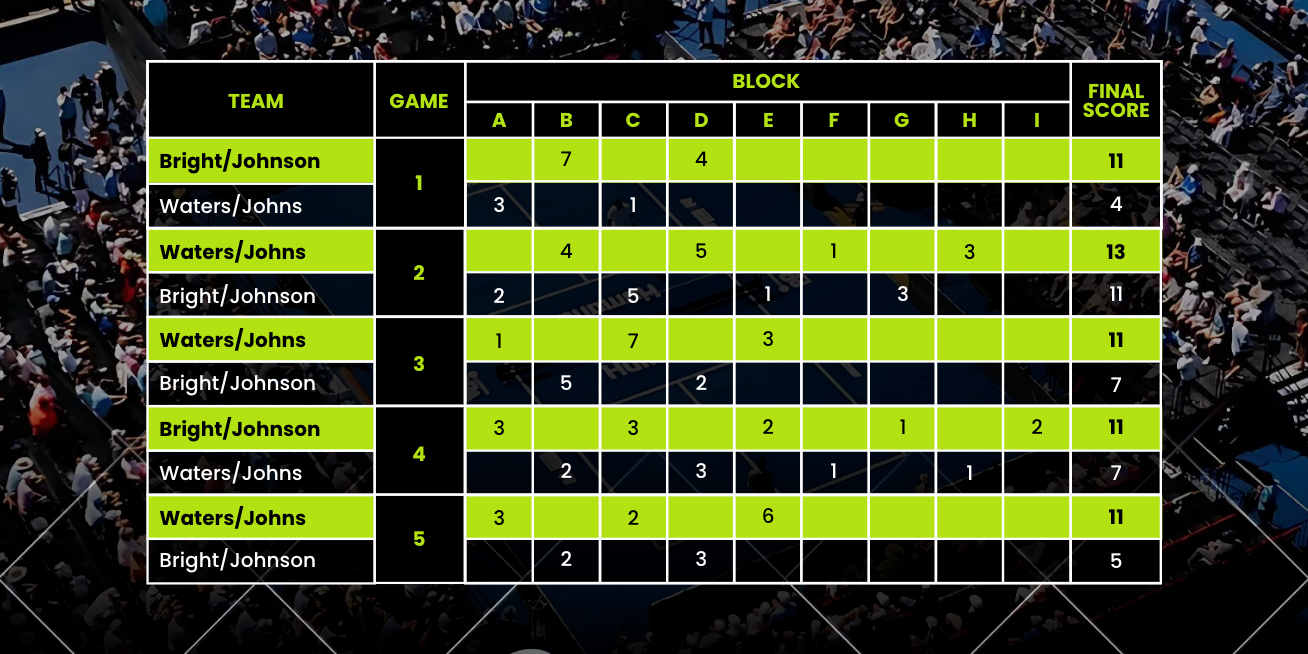
Pickleball Scores Don’t Tell the Whole Story — Here's How You Fix It
Rather than a static line score, block scoring brings a game or match to life by visualizing the momentum swings along the way.
In pickleball, the final score rarely tells the whole story of a game or match. For your consideration: It's time to discuss "Block Scoring."
In traditional pickleball scoring, we know the basics: the first team to 11 points (with a 2-point margin) wins. The match is typically recorded using line scorekeeping — a simple list of final scores, game by game.
But what if there was a way to see how a game was won — not just the final tally?
Introducing: block scoring, a fresh take on documenting the story behind the score.
What Is Block scoring?
Block scoring tracks points in "blocks" — consecutive streaks of points earned by a team — instead of just listing the final score.
Each block is labeled alphabetically (A, B, C...) and alternates based on which team was scoring.
In short, instead of saying "Team A won 11–5," block scoring might show:
- Block A: Team A scores 4
- Block B: Team B scores 2
- Block C: Team A scores 3
- Block D: Team B scores 1
- Block E: Team A scores 4 to win the game
That’s a 5-block game, and it already tells you more than a simple line score.
A Simple Example: One Game
Let’s start with a basic single-game match: Anna Bright and JW Johnson vs. Anna Leigh Waters and Ben Johns in the finals at the PPA Cape Coral Open.
In game 2, Waters/Johns won 13-11. It was a great game, but the score alone doesn't tell the full story.
However, if we block out the scoring, you'd see this:

Block score:
- A: Bright/Johnson – 2
- B: Waters/Johns – 4
- C: Bright/Johnson – 5
- D: Waters/Johns – 5
- E: Bright/Johnson – 1
- F: Waters/Johns – 1
- G: Bright/Johnson – 3
- G: Waters/Johns – 3
Final Score: Waters/Johns 13, Bright/Johnson 11
This shows an incredibly close game with momentum swings throughout. In fact, if not for a strong start from Waters/Johns, this one could have easily gone the other way.
A Deeper Dive: Full Match Breakdown
Let’s now look at the full match.
Compared to a single game block score (above), the score of a full match tells a much more interesting story when laid out block score style.

- Game 1: Bright/Johnson open with a 7-point streak
- Game 2: Waters/Johns and Bright/Johnson trade long streaks — a true battle
- Game 3: Waters/Johns go on a 7-point run to take control
- Game 5: Waters/Johns close the match with a dominant 6-point final block
This was a five-game slug-fest with lots of lead changes and momentum swings.
When Games Get Wild: Close Contests vs Blowouts
Block scoring shines in two scenarios:
- Blowouts – A single 6- or 7-point block can seal the game early (like Game 1, above) or late (like Game 5).
- Back-and-forth battles – Alternating blocks show momentum swings that the final score can’t.
Compare:
- A lopsided game (11–3) might only need 2–3 blocks.
- A tight game (15–13) could require 10+ blocks, especially with frequent momentum changes.

Is 'Block Scoring' New?
Block-style breakdowns exist in some form across other sports. For instance:
- In volleyball, analysts track point runs.
- In tennis, “games won in a row” is sometimes noted.
- In wrestling, scoring breakdowns are grouped by action.
- In baseball, we can see an inning-by-inning report to see where the game was won/lost, not just that the game was won or lost.
But this particular block scoring format is new to pickleball — and possibly unique in the way it visualizes momentum. It's designed to give fans, analysts, and players a clearer window into how games unfold.

Pros and Cons of Block Scoring for Pickleball
Of course, just because it's our idea, doesn't mean it's a good one. Let's examine some pros and cons.
Pros:
- Captures game flow and scoring momentum
- Highly visual
- Great for storytelling and analysis
- Useful for broadcasters, coaches, and stats fans
- Easy to implement for pro matches
Cons:
- Not intuitive to the untrained eye
- More complex to read at a glance
- Takes up more space — especially in long games
- May not be practical for casual or recreational play
Who’s It For?
Block scoring may not replace line scoring, but it adds a layer of depth — perfect for:
- TV broadcasts
- Coaching breakdowns
- Fan engagement
- Match recaps on social or in newsletters
For the pickleball fan who watches live broadcasts or match replays, on-screen displays of the block score during and, particularly, after a game would deliver a high-level perspective of the game’s dynamics, akin to the line score used in televised baseball games.
Pickleball is a game of momentum—block scoring helps bring that to life.
Example: Line Scoring vs. Block Scoring
Drag the line left and right to see the difference between a hypothetical set of match scores and a block score for one game.

Robert S Cormack
Robert works in R&D in the biotech industry in Los Angeles, California. He has been an avid, though mediocre, participant in all manner of sports but only became a pickleball enthusiast last year.










